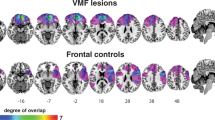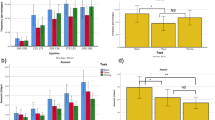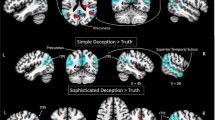Abstract
Replying to: G. Kahane & N. Shackel Nature 452, doi:10.1038/nature06785 (2008)
Kahane and Shackel argue1, on the basis of a re-classification of the moral scenarios used in our study2, that our conclusion of a utilitarian bias among patients with ventromedial–prefrontal–cortex (VMPC) damage is unwarranted. Here we provide a re-analysis of our data based on precisely the classification scheme that Kahane and Shackel suggest. This re-analysis confirms our conclusion that damage to the VMPC results in an increase in utilitarian judgements.
This is a preview of subscription content, access via your institution
Access options
Subscribe to this journal
Receive 51 print issues and online access
$199.00 per year
only $3.90 per issue
Buy this article
- Purchase on Springer Link
- Instant access to full article PDF
Prices may be subject to local taxes which are calculated during checkout
Similar content being viewed by others
References
Kahane, G. & Shackel, N. Do abnormal responses show utilitarian bias? Nature 452, 10.1038/06785 (2008)
Koenigs, M. et al. Damage to the prefrontal cortex increases utilitarian moral judgements. Nature 446, 908–911 (2007)
Wheatley, T. & Haidt, J. Hypnotic disgust makes moral judgments more severe. Psychol. Sci. 16, 780–784 (2005)
Valdesolo, P. & DeSteno, D. Manipulations of emotional context shape moral judgment. Psychol. Sci. 17, 476–477 (2006)
Ciaramelli, E., Muccioli, M., Ladavas, E. & di Pellegrino, G. Selective deficit in personal moral judgment following damage to ventromedial prefrontal cortex. Social Cogn. Affect. Neurosci. 2, 84–92 (2007)
Hauser, M. D. Moral Minds: How Nature Designed a Universal Sense of Right and Wrong (Harper Collins, New York, 2006)
Cushman, F. A., Young, L. & Hauser, M. D. The role of conscious reasoning and intuitions in moral judgment: testing three principles of harm. Psychol. Sci. 17, 1082–1089 (2006)
Young, L., Cushman, F., Hauser, M. & Saxe, R. The neural basis of the interaction between theory of mind and moral judgment. Proc. Natl Acad. Sci. USA 104, 8235–8240 (2007)
Author information
Authors and Affiliations
Rights and permissions
About this article
Cite this article
Koenigs, M., Young, L., Adolphs, R. et al. Koenigs et al. reply. Nature 452, E5–E6 (2008). https://doi.org/10.1038/nature06804
Issue Date:
DOI: https://doi.org/10.1038/nature06804
Comments
By submitting a comment you agree to abide by our Terms and Community Guidelines. If you find something abusive or that does not comply with our terms or guidelines please flag it as inappropriate.



